How do you spend your days at KMD?
What are your dreams for the future?
Five students speak their mind.
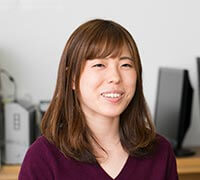
Yuri Osakabe
Japan
Second-year master’s student
Real Project: Policy Project (Digital Kids)
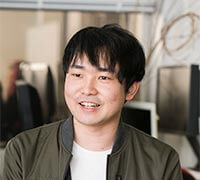
Haruki Nakamura
Japan
Second-year master’s student
Real Project: Embodied Media
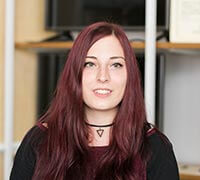
Stefanie Schaack
Germany
Second-year master’s student
Real Project: CREATO!
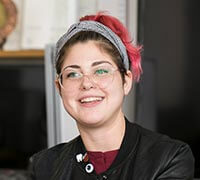
Elaine Czech
America
Second-year master’s student
Real Project: Embodied Media
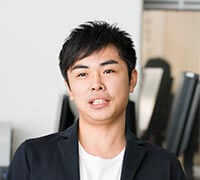
Ichika Komiya
Japan
First-year master’s student
Real Project: Policy Project (Digital Kids)
Please tell us the reason you decided to enroll at KMD.
Yuri: I felt I wanted to engage in activities to enhance the creativity of children while overseeing music at an education faculty during university. It was at this point that I encountered Professor Nanako Ishido’s book, which really impressed me. I entered KMD wanting to learn more about pioneering examples overseas and to get involved in creative workshops.
Haruki: I attended KMD for roughly one month on an internship during my fourth year of study at the National Institute of Technology, Tokyo College. I researched tactile sensation together with students at KMD and also attended an international conference. It was then that I felt that graduate school was for me and decided to enroll.
Stefanie: Since I was very young, I have really liked Japanese anime and visual-kei bands and I ended up studying the Japanese language. While on exchange, I attended Keio University for one year and had heard rumors from other international students that KMD was really interesting. The environment at the school, where people in a variety of fields including business, design, and engineering are brought together, was also very attractive. I originally had an interest in design and felt that I could complement this with my passion for the Japanese language at KMD.
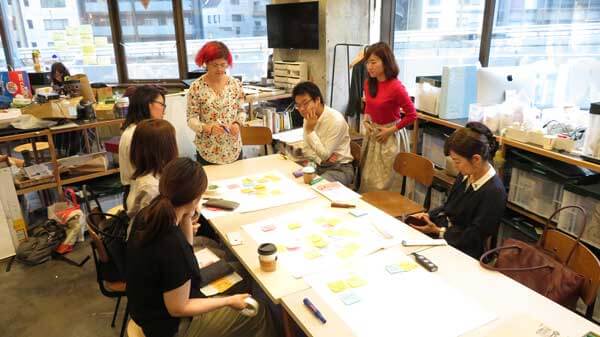
What kind of research are you doing at KMD?
Elaine: I am researching positive aging, which looks at getting older in a positive light. I am currently developing a communication tool for elderly people. For example, I am making an “album” that allows memories to be relived or shared with someone else by recording elderly users narrating old stories to which I add tactile and audio feedback.
Ichika: I am researching STEAM education, an integrated educational approach to learning arts in addition to science, technology, engineering, and mathematics. As I graduated from a college of technology, I adopt this as a theme in my research. For example, I am advancing research to make computer programming education more interesting through matching college students with elementary school students.
Haruki: I am researching a method for sharing data that is generated from vibrations produced by the feeling of a surface in a manner similar to video and audio recordings. For example, I found the project to “record” and share the sensation of stroking a cat at a cat café together with video imagery very interesting.
Stefanie: I am developing an AR game without visuals. Combining multiple sensations such as vibrations, temperatures, and sounds in place of any visual stimuli, I am researching ways to invoke images and emotions in players and to guide them through the game.
Yuri: I am currently researching the adoption of programming education for Japanese pre-school children drawing on examples from overseas such as in the UK. I am thinking of a curriculum that could be put into practice by teachers in the classroom while undertaking actual programming classes for children as part of a joint research project with a nursery.
What is student life like at KMD?
Yuri: In between research and writing my thesis, I am doing various things including PR work for a company that promotes educational tools overseas and a part-time job at a studio on campus managing the music and photography equipment. I am very busy (laughs).
Haruki: In addition to Hiyoshi, the Embodied Media Real Project has sites in Shibuya (Living Lab Shibuya) and Odaiba (Cyber Living Lab). I often move from one site to another to attend meetings or use machinery. For example, after attending a meeting with a company in Shibuya, I might return to Hiyoshi to carry out some instillation work. Sometimes I might visit all three sites in one day.
Ichika: Besides research, my main activity at present is serving as a deputy representative for a community of blockchain developers called Keymakers. Our activities include study groups for developers and launching offices. Because it is basically a community centered on education and the creation of teaching materials, I want to tie this in with my own research on STEAM education for elementary school students.
Stefanie: In the first year, I had classes in the morning and afternoon followed by groupwork, while I interacted with students from separate projects in the KMD Project Room. After that, I spent time at KMD’s partner schools in London and New York on the GID program, which is a design education program linking three cities that are centers for design, culture, and industry, returning to Japan in May. Now, I am concentrating on my research and writing my thesis.
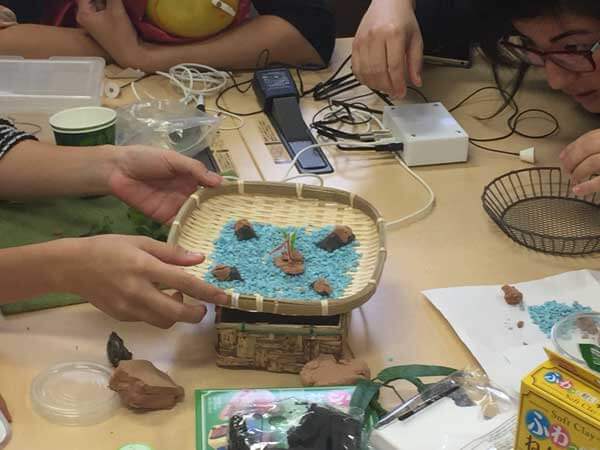
Is there anything that you were surprised about after entering KMD?
Stefanie: European and American universities are tough as they set a large amount of homework. You have to work late into the night every day and then go into class and present your findings. I was surprised by the fact that KMD is completely different. The style at KMD is to learn the concepts and then go on to think about your project by yourself.
Elaine: Because the professors are well-connected in various fields, they will find you a suitable corporate partner for your research. I currently visit a nursing home every week and observe the doctors examining the residents. Securing the cooperation of a corporate partner is what has made this possible.
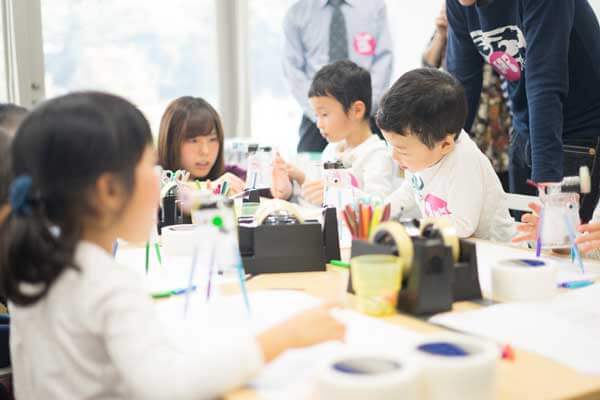
Are there any issues with language?
Elaine: Because I can speak Japanese a little bit, I am able to get by in both daily life and research. However, because it is difficult to communicate with elderly people in Japan who are the focus of my research unless you are proficient in Japanese, I receive help from my corporate partner.
Stefanie: If you cannot speak any Japanese, then perhaps daily life in Japan could prove a little bit of a struggle. If this does happen, we help each other out by going together to the ward office or sharing information such as how to pay the rent.
Yuri: We basically use Japanese and English, but you sometimes have to speak wholly in English when many international students belong to a project. It is really international at KMD as students from all over the world attend and there is always a variety of languages being spoken other than English.
Have there been any events that left a lasting impression?
Yuri: Well of course, there is the KMD Forum. It is both a festival for the students and place to present our research outcomes. The event is managed and promoted by the students. I helped with the preparations over the last six months as a core member. This year is the tenth anniversary of KMD and the forum introduced the journey the school has taken over the last decade. There was a keynote speech by Mr. Tim Brown of IDEO and the event was really lively with over 1,000 visitors. Although the preparations for the event were tough, I received feedback about my research from visitors and it was an opportunity to collect research data from the many people who attended.

What advice do you have for people thinking about enrolling at KMD at some point?
Stefanie: It is best to decide your research topic as quickly as possible before entering KMD because the two years really do fly by.
Ichika: The first big step is listening to what is said at a KMD information session and thinking “this is for me.” After entering KMD, perhaps the most important thing is being able to express and assert yourself and say “this is what I have done up to now, let’s do something together.”
Haruki: There are many cases where students start new projects together which draw on their activities or internships at places other than KMD.
Yuri: There are a lot of opportunities and possibilities for collaboration at KMD. However, this isn’t something that is just given to you on a plate but is something that you have to go out and take hold of by yourself. Because KMD feels more like a large community than a school, people who do not take the initiative might miss out on these opportunities. Someone who enjoys being proactive will definitely flourish.
What you would like to do from here on out?
Elaine: I enjoy studying, so I would like to continue to pursue my research on various things.
Haruki: I will find work as an engineer at a company in networking and communications. I would like to leverage the community fostered at KMD in order to contribute to society.
Yuri: Next year, I have decided to advance to the doctoral program at KMD to further expand on my current research and develop my expertise while continuing to work as an Education Specialist at the company where I presently work.
Stefanie: I have secured my dream job at a Japanese videogame company. I would like to contribute to worldwide gaming through planning and production in the videogame business.
Ichika: In any case, I want to gain experience in various fields from electronic controls to VR, AI, and blockchains. Drawing on these experiences, I would like to take on the role of connecting people together and to realize my vision of making society just that little bit richer.
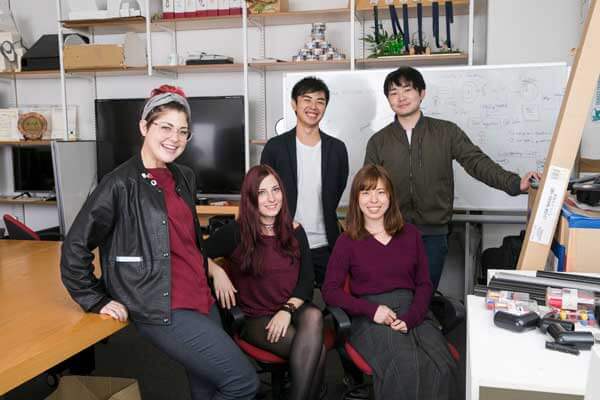
(This interview was held in November 2018)